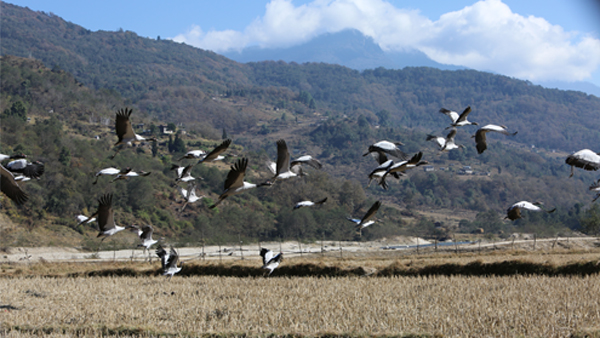 The annual count of globally endangered Black-necked Crane saw some 555 cranes including 52 juveniles, along the protected habitats in the country.
The annual count of globally endangered Black-necked Crane saw some 555 cranes including 52 juveniles, along the protected habitats in the country.
Compared to last year, which saw a total of 609 cranes including 68 juveniles, this year the number dropped by 54.
The Royal Society for Protection of Nature (RSPN) carried out the annual count, considering the number of cranes in the winter habitats to be at its peak around this time of the year.
Migration of the Black-necked Crane from the Tibetan Plateau is usually considered complete by this time of the year.
Bird specialists consider first week of February, the most appropriate time to carry out the annual count.
Phobji valley in Wangdue Phodrang, which has been declared a protected habitat for the cranes since 2003, saw 437 cranes including 44 juveniles. Last year the valley saw 457 cranes.
 Boomdeling valley in Trashi Yangtse saw 92 cranes of which 6 are juveniles. Similarly, 12 cranes are spotted in Khotokha in Wangdue Phodrang, 10 in Bumthang and 4 in Lhuentse.
Boomdeling valley in Trashi Yangtse saw 92 cranes of which 6 are juveniles. Similarly, 12 cranes are spotted in Khotokha in Wangdue Phodrang, 10 in Bumthang and 4 in Lhuentse.
A researcher from Ugyen Wangchuck Institute of Conservation and Environment (UWICE), Sherab attributed the possible reasons for the decrease could be higher mortality rates or unsuccessful breeding among the cranes.
He also added that the GPS tags on the cranes showed their movements further north into high altitude regions from the northern border.
Black-necked Crane is categorized as vulnerable in the International Union for Conservation of Natures’ Red List of Threatened Species.
In Bhutan the crane enjoys a celebrity status as witnessed through the Crane Festival held annually on November 12 at Gangtey Monastery upon the cranes’ arrival to its winter habitat.
The cranes migrate towards warmer region during winter from their summer habitats in Tibetan Plateau, in the last week of October. The birds fly back to their summer habitats between mid February to first week of March.
The highest count in the past 31 winter period records was observed in the year 2015-2016, maintained with the Royal Society for Protection of Nature.












